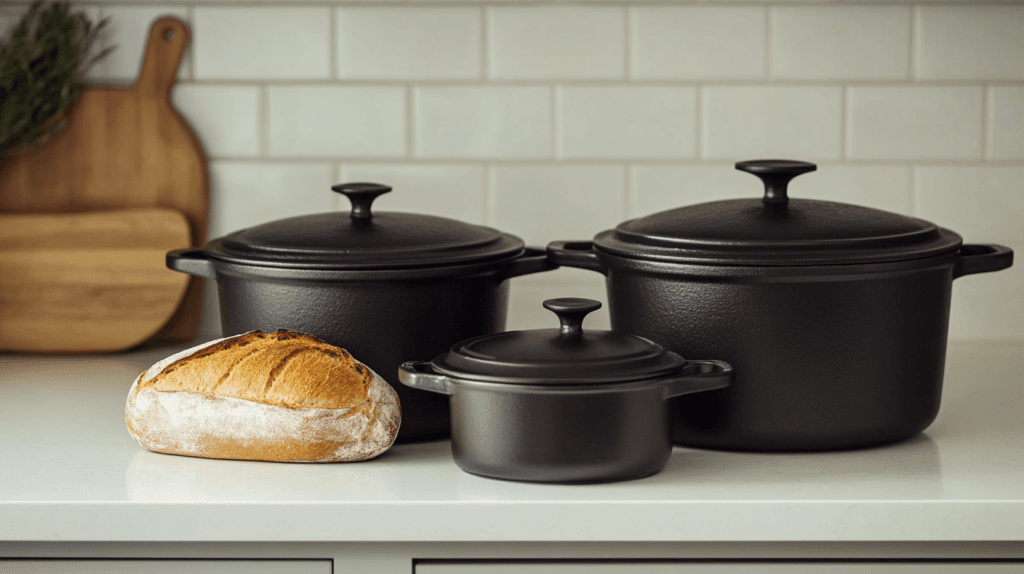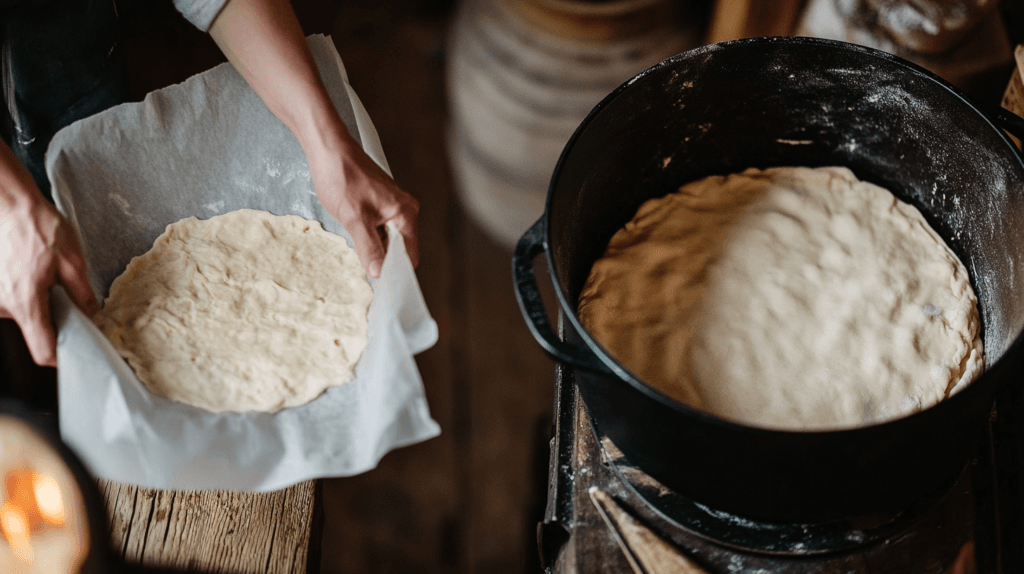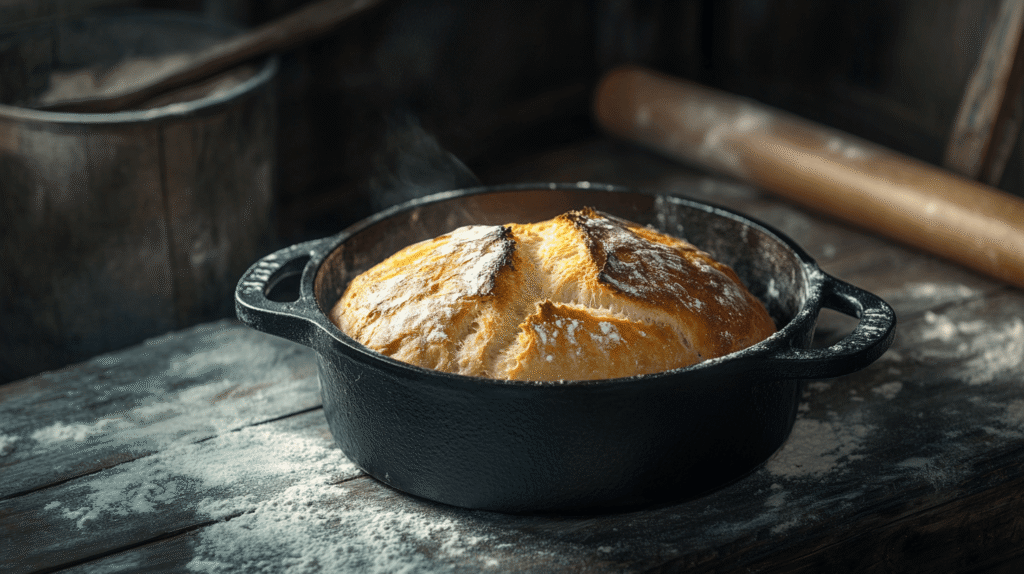When it comes to baking the perfect loaf of bread, a Dutch oven is a baker’s best friend. Its ability to trap steam and maintain a consistent temperature creates an ideal environment for dough to rise and crust to form. But one question often arises: What size Dutch oven for bread?
Choosing the right size Dutch oven can mean the difference between a beautifully risen boule and a flat, underwhelming loaf. In this article, we’ll explore everything you need to know about selecting the perfect Dutch oven size for bread, from standard size recommendations to the best options for different types of loaves.
Let’s dive into the details and help you become a master of bread baking with the right Dutch oven by your side!
Table of Contents
Why a Dutch Oven is Essential for Bread Baking
Baking bread is both an art and a science, and the tools you use can significantly impact the final result. A Dutch oven has become a staple for bread bakers worldwide due to its unique ability to replicate the conditions of a professional steam oven. Here’s a deeper dive into why a Dutch oven is indispensable for baking bread.
Steam Retention: The Secret to a Perfect Crust
One of the most critical elements in bread baking is steam. When dough enters the oven, the outer layer quickly dries out unless steam is present. A Dutch oven traps moisture released from the dough, enveloping it in steam during the initial baking phase. This process:
- Encourages Oven Spring: The loaf expands rapidly in the first 10-15 minutes.
- Develops a Crispy Crust: Steam prevents the crust from setting too early, allowing it to become beautifully caramelized and crunchy.
- Enhances Appearance: Steam creates a glossy, professional finish on the crust, perfect for artisan loaves.
Heat Retention and Even Distribution
Bread requires consistent, high temperatures for optimal results. The thick cast iron walls of a Dutch oven retain heat effectively and distribute it evenly, ensuring:
- Uniform Baking: No hot spots mean the bread cooks evenly, avoiding underbaked centers or overly browned crusts.
- Reliable Results: Dutch ovens maintain their temperature even when you open the oven, which can be crucial for consistent bakes.
Versatility in Bread Baking
Dutch ovens can accommodate various bread types and techniques. Whether you’re baking a rustic sourdough boule, a crusty rye loaf, or experimenting with enriched bread like brioche, a Dutch oven adapts to your needs. It works equally well in a home kitchen or over an open flame.
Mimicking a Professional Steam Oven
In commercial bakeries, steam injection ovens are the norm for high-quality bread. At home, a Dutch oven provides a cost-effective alternative, creating the same environment by trapping steam naturally. This makes it an invaluable tool for hobbyist bakers striving for professional-level results.
Understanding Dutch Oven Sizes

Selecting the right size Dutch oven is more than a matter of convenience; it directly affects the quality of your bread. Let’s delve deeper into Dutch oven sizes and how they influence the bread-baking process.
How Dutch Oven Sizes Are Measured
Dutch ovens are typically measured by their quart capacity. The size refers to the volume the Dutch oven can hold, which determines the type and size of bread it can bake. Here’s a quick guide:
- Small (2-3 Quarts): Suitable for mini loaves or small bread batches.
- Medium (4-5 Quarts): The most versatile size for standard loaves (1-2 pounds).
- Large (6-8 Quarts): Best for larger loaves, family-sized recipes, or multiple loaves.
Matching Size to Dough Volume
Choosing the correct size Dutch oven ensures the dough has enough space to expand without overflowing or spreading out too thin. Here’s how to match dough volume to Dutch oven size:
- 1-2 Pound Loaf: A 4-5 quart Dutch oven is perfect for these standard-sized loaves.
- 2.5-4 Pound Loaf: Opt for a 6-quart Dutch oven to prevent overcrowding.
- Mini Breads or Rolls: A smaller 2-3 quart Dutch oven can bake petite loaves or rolls effectively.
The Impact of Size on Bread Texture and Crust
- Too Small: A cramped Dutch oven can force the dough to rise unevenly, leading to dense spots or irregular shapes.
- Too Large: Excess space reduces the concentration of steam, which is vital for creating a crisp, glossy crust.
Round vs. Oval Dutch Ovens
The shape of your Dutch oven also matters, particularly for specific bread types:
- Round Dutch Ovens: Ideal for boules and round artisan loaves. The shape promotes even rising and baking.
- Oval Dutch Ovens: Better suited for baguettes or long, oval-shaped loaves. They offer the length and space needed for these bread types.
Practical Tips for Choosing the Right Size
- Consider Your Recipe: Always check the expected dough size and match it to the Dutch oven’s capacity.
- Future-Proofing: If you plan to experiment with larger loaves or family-sized recipes, a 6-quart Dutch oven offers flexibility.
- Storage and Handling: Larger Dutch ovens are heavier and bulkier, so ensure you have space to store and handle them safely.
Common Dutch Oven Sizes for Specific Bread Types
| Bread Type | Ideal Dutch Oven Size | Suggested Shape |
|---|---|---|
| Boule (Round Loaf) | 4-5 quarts | Round |
| Baguette (Long Loaf) | 5-7 quarts | Oval |
| Sourdough Loaf | 4-6 quarts | Round or Oval |
| Multigrain/Rye Bread | 5-6 quarts | Round |
| Large Batch Baking | 6-8 quarts | Round or Oval |
Understanding Dutch oven sizes is essential for both beginners and seasoned bakers. The right size ensures your bread bakes perfectly, every time, with a golden crust and tender crumb.
What size Dutch oven for bread: Different Bread Types
Artisan Bread: Loaves and Boules
For artisan bread like rustic loaves or round boules, a 4-5 quart Dutch oven is the sweet spot. This size comfortably fits a standard loaf, allowing enough space for the dough to expand while trapping steam efficiently.
- Why 4-5 Quarts Work: The size ensures the dough has room to rise without spreading too thin, resulting in a high-domed crust.
- Shape Consideration: Round Dutch ovens pair perfectly with round loaves for even baking.
Baguettes and Long Loaves
Baguettes and elongated loaves require a different approach:
- An oval Dutch oven with a capacity of 5-7 quarts works best for these types of bread.
- Tip: If you don’t have an oval-shaped Dutch oven, you can partially shape the dough to fit a round one, though the presentation may differ.
Specialty Bread: Sourdough, Rye, and More
For sourdough and other specialty bread, the ideal size depends on the batch size:
- Single Loaf (1-2 pounds): A 4.5-quart Dutch oven is excellent.
- Larger Loaves (3-4 pounds): Opt for a 6-quart Dutch oven to accommodate the extra volume.
- Multiple Loaves: Larger Dutch ovens, 7 quarts or more, are suitable for batch baking or larger recipes.
Factors to Consider When Choosing a Dutch Oven Size
Bread Batch Size
The number of loaves you plan to bake should guide your decision:
- Single Loaf Baking: Stick to a 4-5 quart Dutch oven for efficiency and a snug fit.
- Double Batch Baking: Use a 6-8 quart Dutch oven to ensure enough space without overcrowding.
Oven Space and Storage Considerations
Dutch ovens are heavy and bulky, so think about:
- Storage Space: Ensure you have a spot to keep the Dutch oven when not in use.
- Oven Compatibility: Measure your oven to confirm it can accommodate the size of your Dutch oven, especially larger ones.
Material and Weight of the Dutch Oven
Larger Dutch ovens weigh more, which may impact ease of handling. Consider:
- Cast Iron vs. Enameled: While both are excellent, enameled versions offer easier cleaning and no seasoning requirements.
- Weight: Larger sizes can be challenging to move when hot, so plan accordingly.
Expert Recommendations for Dutch Oven Sizes
Best Dutch Oven Size for Beginners
If you’re just starting your bread-baking journey, a 4.5-quart round Dutch oven is the most versatile choice. It accommodates a standard loaf size and works well for various recipes.
- Advantages: Easy to handle, fits most oven types, and is perfect for learning.
Advanced Bakers: Customizing for Larger Batches
Experienced bakers handling larger recipes or specialty bread will benefit from:
- 6-8 Quart Dutch Ovens: These are ideal for large sourdough loaves or multiple loaves at once.
- Tip for Advanced Bakers: Consider owning two sizes – one medium (4-5 quarts) and one large (6-8 quarts) for maximum flexibility.
Tips for Using a Dutch Oven Effectively

Preheating the Dutch Oven
Preheating is essential to achieving a perfect crust:
- Place the Dutch oven (with the lid on) in your oven during the preheating phase.
- Allow it to heat for at least 30 minutes at the baking temperature.
- Why This Works: Preheating ensures the dough begins baking immediately, which helps with oven spring and crust formation.
Maintaining Optimal Dough Expansion
- Don’t Overcrowd: Always choose a Dutch oven that provides at least an inch of space around the dough to allow for full expansion.
- Use Parchment Paper: It helps transfer the dough easily into the hot Dutch oven and prevents sticking.
Cleaning and Caring for Your Dutch Oven
- Avoid Abrasive Tools: Use soft sponges to clean enameled surfaces.
- Season Bare Cast Iron: Apply a thin layer of oil to maintain non-stick properties and prevent rust.
- Store with Lid Slightly Ajar: This prevents moisture buildup and preserves the Dutch oven’s longevity.
FAQS About Dutch Oven Sizes for Bread
What is the Best Size Dutch Oven for a Single Loaf of Bread?
For a single loaf of bread, a 4-5 quart Dutch oven is ideal. This size provides enough space for a standard 1-2 pound loaf to rise and bake evenly while retaining steam for a perfect crust. Want to dive deeper into Dutch oven sizes? Check out our complete guide on choosing the best Dutch oven for sourdough bread.
Can I Use a Large Dutch Oven for Small Batches of Bread?
Yes, you can use a larger Dutch oven, but it may not be as effective for smaller batches. In a larger oven, excess space can lead to inadequate steam retention, which may affect the crust’s texture. If you must use a larger Dutch oven, consider placing a smaller heatproof dish inside to help concentrate the steam.
How Heavy Are Dutch Ovens, and Does Size Affect Handling?
Dutch ovens are made of cast iron, which makes them heavy. Larger models (6-8 quarts) can weigh 15 pounds or more when empty. When choosing a size, prioritize one you can handle comfortably, especially if you plan to bake frequently. Looking for more guidance? Read our expert tips on selecting the right Dutch oven size for sourdough.
Are Enameled Dutch Ovens Better for Bread Baking?
Enameled Dutch ovens are an excellent choice for bread baking because:
- They are easy to clean and require no seasoning.
- The smooth interior helps prevent sticking.
- They retain and distribute heat just as effectively as bare cast iron.
While enameled models are more expensive, they offer convenience and are highly durable.
What Happens if the Dutch Oven is Too Big for My Loaf?
If your Dutch oven is too large for your loaf, the bread may spread out instead of rising upward. Additionally, the excess space can reduce steam concentration, impacting crust development. To prevent your loaf from spreading, try using a smaller loaf pan or shaping the dough more tightly. You can also find more tips in our detailed guide on baking bread in a Dutch oven.
Conclusion
Choosing the right size Dutch oven for bread is a game-changer for home bakers. For most standard loaves, a 4-5 quart Dutch oven is the perfect choice, offering just the right balance of space and steam retention. For larger loaves or batch baking, a 6-8 quart Dutch oven provides the flexibility and capacity needed.
Whether you’re a beginner or an advanced baker, understanding the role of Dutch oven size ensures your bread turns out beautifully every time. With this guide, you’re well-equipped to select the perfect Dutch oven and take your bread-baking skills to the next level.

